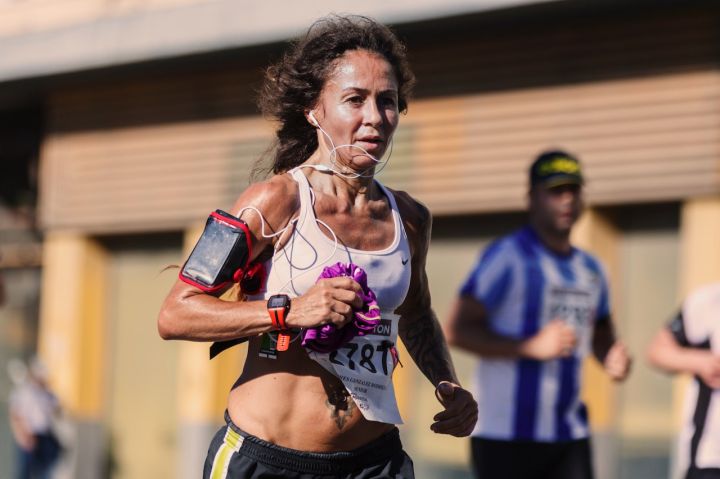Muscle soreness is a normal part of your recovery process after a workout, and it will start once you've finished your fitness training.
However, these sorenesses are telling you about different conditions in your body after training. There are several levels of soreness that we need to pay extra attention to:
Typical mild muscle soreness

This first type of pain is typical of mild muscle pain. Although scientists have been "Splitting hairs" About the real cause of this pain, it is generally accepted that it is caused by microtrauma at the level of the muscle fibres and an excessive build-up of lactic acid. In any case, it is important to note that this is a benign pain because it is of a mild nature and muscle function is not impaired. This condition may last a day in advanced athletes and up to 3 days in beginners. This pain is a good indicator that you had a good workout the day before, as you caused the trauma (such as muscle growth) needed to trigger the adaptation. When you no longer experience this pain, then it is an indication that your body has successfully adapted to the training programme.
Delayed onset muscle soreness

The second type of muscle soreness is delayed onset muscle soreness, also known as delayed muscle soreness. This refers to muscle soreness that usually occurs two days after the end of exercise (rather than the next day). This pain prevents the muscle from fully contracting. This more severe pain is caused when you start exercising for the first time in a long time or when you haven't worked out a particular area for a long time. This pain may last for a few days, and for an advanced athlete in good shape, it may last for a week. If you are suffering from this pain and it is time to work out again, we have found that the best thing to do is not to take a day off, but to exercise and perform active recovery activities. Active recovery, as i mention here, does not follow the plan to train as usual. Rather, all loads are reduced by 50% so that other problems are not triggered. For example, if you can do a set of 10 repetitions, divide the weight you normally use for this workout by 2 and that's the weight you'll use that day.
Again, stop the exercise, even if you won't experience muscle exhaustion by the tenth exercise. The purpose of this exercise is to allow the full movement of the muscles that need to be restored and to remove the lactic acid and other waste products from them. At the same time, it forces a high concentration of blood into the damaged area to provide the muscles with the nutrients they need to repair and grow. These practices are definitely very powerful for your recovery as you will be less sore or stiff by the next day, and you do not avoid exercise in the name of recovery by waiting for the pain to go away on its own in a week or so.
Injury category muscle soreness

The third type of pain is caused by an injury. This type of pain is quite different in nature from the two above, as it is usually static and very sharp. Depending on the nature of the injury, it is only felt when the muscle is moving in a certain way or constantly. Sometimes these injuries become obvious as soon as they occur. The rest of the next day. If you are injured, the first thing you should do is apply the "Rice" Principle (rice, the letters r, i, c and e stand for recovery, ice, compression and elevation). In consultation with a doctor, some injuries allow you to continue training while injured (in other words, find exercises that target the injured muscle without involving the range of motion that triggered the pain). Other, more serious injuries, such as muscle tears, may involve the entire injured area and, depending on the severity, may even require surgery. So, when you strength train, put blind arrogance aside.
Don't bring it into the gym because it could lead to an injury that will not only keep you out of the gym for a while, but it will seem to haunt you long after you think you have fully recovered. Therefore, there is no doubt that the best way to prevent this pain is to keep repeating the exercises and developing good posture.
There are a few tips to help you manage and control the first two types of muscle soreness
Ensure proper nutrition.

Although this should be obvious, many people miss out on this opportunity. If you don't put in the right amount of carbohydrates (generally 2 - 4 grams per kilogram of body weight, but also depending on your metabolic rate), 2 grams of protein per kilogram of body weight and 15 - 20% of your total daily calories from good fats, know that your body will not recover and grow when it is undernourished.
Drink plenty of water :

Although this may not seem "Technical", over 66% of muscle is water. Therefore, it is very important to drink water. You need your body weight in kilograms x 0.044 litres of water per day in order to function properly. So if your weight is 90 kg then you need almost 4 litres of water per day. If you don't have enough water in your body, your body's ability to detoxify will be compromised and your recovery will be adversely affected.
Make your training regular and keep it to no more than 60 minutes:

If you train at high intensity all the time, this will inevitably lead to overtraining and even injury. The same is true if your sets and reps are too high. It is therefore important to distribute your training properly by controlling the number of reps and the weight you train. Alternate between high reps and low weight training (10-15 reps) and low reps and high weight training (6-8 reps). Also, in order to keep your anabolic hormone levels high, do not train for more than 60 minutes (45 minutes is better). After 60 minutes, testosterone levels drop and cortisol levels rise. Therefore, training for more than 60 minutes can lead to an increase in cortisol levels, which can affect recovery.
Do some aerobic exercise.

It has been proven in studies that doing 30 minutes of aerobic exercise three to four times a week can help speed up your recovery as the extra oxygen and circulation training helps to flush toxins and lactic acid from the body. So don't neglect your aerobic exercise.
Alternating cold/hot showers.

Alternating hot and cold showers (30 seconds of cold water and 1 minute of hot water) is a great way to help flush out toxins and lactic acid. Cold water causes vasoconstriction while hot water causes vasodilation. You can use this simple method after strenuous exercise. Usually, i recommend doing 3-5 rounds of alternating hot and cold showers.
Massage.

Massage aids lymphatic movement (a fluid that helps remove waste from body tissues), which combines with the blood to help provide oxygen and nutrients while helping to remove body waste and toxins. Ideally, the more frequently you train, the more frequently you will receive a massage and having a massage once a month will do wonders for your overall recovery.
Tissue enzyme supplement.

Tissue enzymes play a vital role in your metabolism, including muscle and tissue recovery. (you may see these enzymes also referred to as metabolic enzymes or protein hydrolases.) virtually every process in your body, from muscle function to immune response, from thinking to energy creation, relies on tissue enzymes.
The role of tissue enzymes in healing has been known for many years. Recently, however, studies by researchers have shown that tissue enzymes can reduce exercise-induced pain reduce inflammation and promote faster healing.
It is possible that it could be supplemented. There are two types of enzymes that can be extracted, one from animals and the other from plants.
Pineapple protease, for example, comes from pineapples. Some other well-known plant enzymes include, papain, which comes from papaya and is known for its ability to break down the toughest protein fibres. Nattokinase, found in fermented soybeans, breaks down fibrous protein.
So you can eat more pineapple, papaya and natto to get these beneficial enzymes. Of course you can also supplement from special supplements.
Glutamine supplementation:
Glutamine is the most abundant amino acid in muscle cells. It is released from the muscles during times of stress (e.g. Weight training, workouts) and when dieting. This amino acid has not only proven to be a powerful anti-catabolic substance (protecting muscles from the catabolic activity of the hormone cortisol), a contributor to muscle cell volume and has immune system enhancing properties.
Have some creatine:
Creatine has been shown time and time again to aid recovery not only from recovery, but also after exercise. Half a scoop (2.5g) before and after a workout can boost your recovery.
Get plenty of sleep:

If you don't get enough sleep, your cortisol levels will spike, recovery will be impaired, and your likelihood of injury or illness will increase. The most important thing is that a person has as much sleep as possible, 8 hours is ideal.

All of these methods may help us to relieve, the first two types of muscle soreness. And for the injury category muscle soreness, one must see a doctor first to determine if it is okay to continue exercising.





